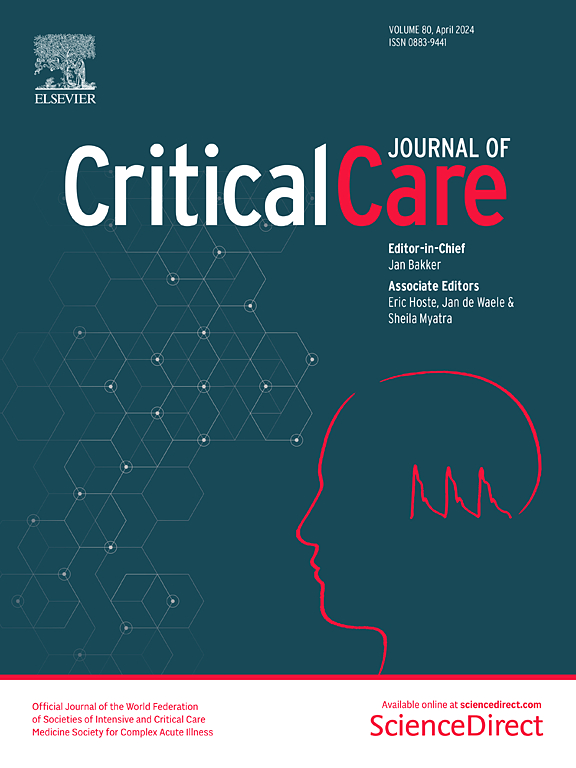ICU mortality of post-myocardial infarction ventricular septal defect complicated by cardiogenic shock: a retrospective multicentric cohort
IF 8.8
1区 医学
Q1 CRITICAL CARE MEDICINE
引用次数: 0
Abstract
Post myocardial infarction ventricular septal defect (PMI-VSD) complicated by refractory cardiogenic shock is associated with an extremely high mortality rate. We sought to evaluate the factors associated with in-ICU mortality in patients with PMI-VSD-related cardiogenic shock. Patients with PMI-VSD complicated by cardiogenic shock, admitted in 10 French tertiary centers between 2008 and 2022, were retrospectively included. The primary outcome was in-ICU mortality. The timing of surgery was classified as early (≤ 7 days) or late (> 7 days). Multivariable analysis was performed to identify the variables associated with in-ICU mortality. A total of 138 patients were included (mean age 70 (± 10) years, female sex 54%). Of these, 116 patients (84%) received MCS, including 43 patients (31%) with VA-ECMO. VSD surgical closure was performed in 93 patients (67%, 60 early, 33 late). Only 2 patients had percutaneous closure without surgical repair. A total of 84 patients (61%) died. The type of surgical management strategy was significantly associated with in-ICU mortality (no surgery, 100%; early surgery, 45%; late surgery, 27%; ptrend < 0.001). In all patients, the variables independently associated with in-ICU mortality were: old age (adjusted OR = 1.1, 95%CI [1.02–1.12.], p = 0.004), SOFA score (adjusted OR = 1.2, 95%CI [1.07.-1.37], p = 0.003), and VA-ECMO (adjusted OR = 2.9, 95%CI [1.2–7.7], p = 0.02). In patients with VSD surgical closure, a longer delay between ICU admission and VSD surgical closure was independently associated with decreased in-ICU mortality (adjusted OR = 0.9, 95%CI [0.79–0.96], p = 0.003). Delayed VSD closure is associated with improved outcomes in PMI-VSD complicated by cardiogenic shock. #CE SRLF 19-34, #CNIL MR004 2224973, retrospectively registered 04 July 2019 Abbreviations: d day; ICU intensive care unit; SOFA sequential organ failure assessment; VA-ECMO veno-arterial extracorporeal membrane oxygenation; VSD ventricular septal defect; w with.VSD repair is equivalent to VSD surgical closure and do not include the patients (n=2) who underwent percutaneous closure only.心肌梗死后室间隔缺损并发心源性休克的ICU死亡率:一项回顾性多中心队列研究
心肌梗死后室间隔缺损(PMI-VSD)合并难治性心源性休克的死亡率极高。我们试图评估与pmi - vsd相关心源性休克患者在icu死亡率相关的因素。回顾性分析了2008年至2022年间法国10个三级中心收治的伴有心源性休克的PMI-VSD患者。主要终点是icu内死亡率。手术时间分为早期(≤7天)和晚期(≤7天)。进行多变量分析以确定与icu死亡率相关的变量。共纳入138例患者,平均年龄70(±10)岁,女性54%。其中116例(84%)患者接受了MCS,其中43例(31%)患者接受了VA-ECMO。手术封堵室间隔缺损93例(67%,早期60例,晚期33例)。仅有2例患者行经皮闭锁术,未行手术修复。84例患者(61%)死亡。手术处理策略的类型与icu内死亡率显著相关(无手术,100%;早期手术,45%;晚期手术,27%;p趋势< 0.001)。在所有患者中,与icu内死亡率独立相关的变量为:年龄(调整后OR = 1.1, 95%CI [1.02-1.12]);], p = 0.004),沙发的分数(调整或= 1.2,95% ci [1.07.-1.37], p = 0.003),和VA-ECMO(调整或= 2.9,95% ci [1.2 - -7.7], p = 0.02)。对于VSD手术关闭的患者,较长的ICU入院和VSD手术关闭之间的延迟与ICU内死亡率降低独立相关(调整后OR = 0.9, 95%CI [0.79-0.96], p = 0.003)。延迟室间隔关闭与pci -VSD合并心源性休克的预后改善相关。#CE SRLF 19-34, #CNIL MR004 2224973,追溯注册于2019年7月4日ICU重症监护病房;SOFA序贯器官衰竭评估;VA-ECMO;静脉-动脉体外膜氧合;室间隔缺损;w。VSD修复等同于VSD手术闭合,不包括仅经皮闭合的患者(n=2)。
本文章由计算机程序翻译,如有差异,请以英文原文为准。
求助全文
约1分钟内获得全文
求助全文
来源期刊

Critical Care
医学-危重病医学
CiteScore
20.60
自引率
3.30%
发文量
348
审稿时长
1.5 months
期刊介绍:
Critical Care is an esteemed international medical journal that undergoes a rigorous peer-review process to maintain its high quality standards. Its primary objective is to enhance the healthcare services offered to critically ill patients. To achieve this, the journal focuses on gathering, exchanging, disseminating, and endorsing evidence-based information that is highly relevant to intensivists. By doing so, Critical Care seeks to provide a thorough and inclusive examination of the intensive care field.
 求助内容:
求助内容: 应助结果提醒方式:
应助结果提醒方式:


